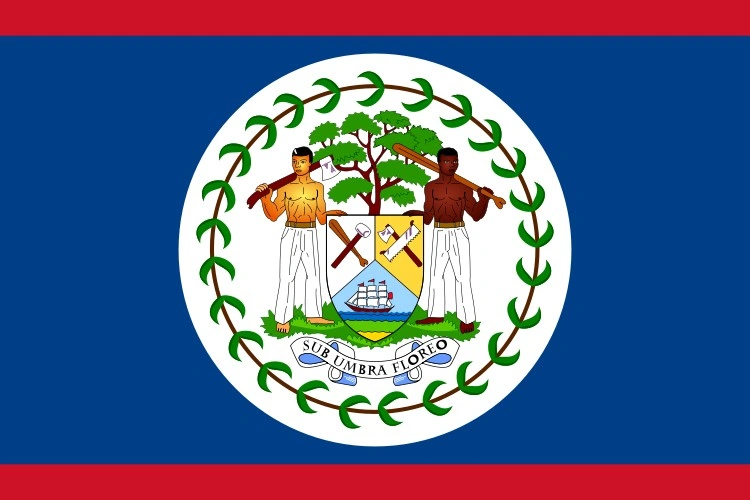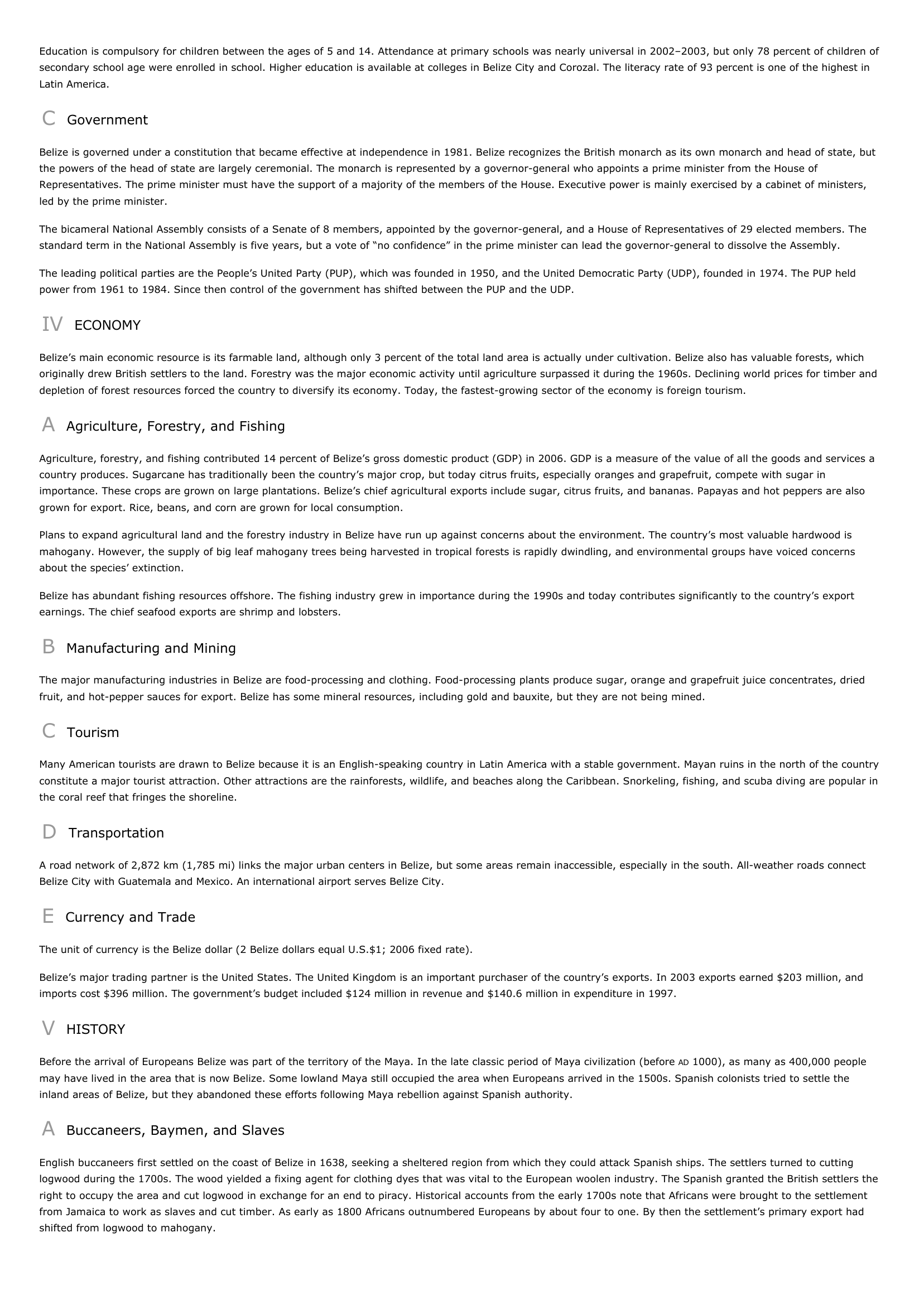Belize - country.
Publié le 04/05/2013

Extrait du document


«
Education is compulsory for children between the ages of 5 and 14.
Attendance at primary schools was nearly universal in 2002–2003, but only 78 percent of children ofsecondary school age were enrolled in school.
Higher education is available at colleges in Belize City and Corozal.
The literacy rate of 93 percent is one of the highest inLatin America.
C Government
Belize is governed under a constitution that became effective at independence in 1981.
Belize recognizes the British monarch as its own monarch and head of state, butthe powers of the head of state are largely ceremonial.
The monarch is represented by a governor-general who appoints a prime minister from the House ofRepresentatives.
The prime minister must have the support of a majority of the members of the House.
Executive power is mainly exercised by a cabinet of ministers,led by the prime minister.
The bicameral National Assembly consists of a Senate of 8 members, appointed by the governor-general, and a House of Representatives of 29 elected members.
Thestandard term in the National Assembly is five years, but a vote of “no confidence” in the prime minister can lead the governor-general to dissolve the Assembly.
The leading political parties are the People’s United Party (PUP), which was founded in 1950, and the United Democratic Party (UDP), founded in 1974.
The PUP heldpower from 1961 to 1984.
Since then control of the government has shifted between the PUP and the UDP.
IV ECONOMY
Belize’s main economic resource is its farmable land, although only 3 percent of the total land area is actually under cultivation.
Belize also has valuable forests, whichoriginally drew British settlers to the land.
Forestry was the major economic activity until agriculture surpassed it during the 1960s.
Declining world prices for timber anddepletion of forest resources forced the country to diversify its economy.
Today, the fastest-growing sector of the economy is foreign tourism.
A Agriculture, Forestry, and Fishing
Agriculture, forestry, and fishing contributed 14 percent of Belize’s gross domestic product (GDP) in 2006.
GDP is a measure of the value of all the goods and services acountry produces.
Sugarcane has traditionally been the country’s major crop, but today citrus fruits, especially oranges and grapefruit, compete with sugar inimportance.
These crops are grown on large plantations.
Belize’s chief agricultural exports include sugar, citrus fruits, and bananas.
Papayas and hot peppers are alsogrown for export.
Rice, beans, and corn are grown for local consumption.
Plans to expand agricultural land and the forestry industry in Belize have run up against concerns about the environment.
The country’s most valuable hardwood ismahogany.
However, the supply of big leaf mahogany trees being harvested in tropical forests is rapidly dwindling, and environmental groups have voiced concernsabout the species’ extinction.
Belize has abundant fishing resources offshore.
The fishing industry grew in importance during the 1990s and today contributes significantly to the country’s exportearnings.
The chief seafood exports are shrimp and lobsters.
B Manufacturing and Mining
The major manufacturing industries in Belize are food-processing and clothing.
Food-processing plants produce sugar, orange and grapefruit juice concentrates, driedfruit, and hot-pepper sauces for export.
Belize has some mineral resources, including gold and bauxite, but they are not being mined.
C Tourism
Many American tourists are drawn to Belize because it is an English-speaking country in Latin America with a stable government.
Mayan ruins in the north of the countryconstitute a major tourist attraction.
Other attractions are the rainforests, wildlife, and beaches along the Caribbean.
Snorkeling, fishing, and scuba diving are popular inthe coral reef that fringes the shoreline.
D Transportation
A road network of 2,872 km (1,785 mi) links the major urban centers in Belize, but some areas remain inaccessible, especially in the south.
All-weather roads connectBelize City with Guatemala and Mexico.
An international airport serves Belize City.
E Currency and Trade
The unit of currency is the Belize dollar (2 Belize dollars equal U.S.$1; 2006 fixed rate).
Belize’s major trading partner is the United States.
The United Kingdom is an important purchaser of the country’s exports.
In 2003 exports earned $203 million, andimports cost $396 million.
The government’s budget included $124 million in revenue and $140.6 million in expenditure in 1997.
V HISTORY
Before the arrival of Europeans Belize was part of the territory of the Maya.
In the late classic period of Maya civilization (before AD 1000), as many as 400,000 people may have lived in the area that is now Belize.
Some lowland Maya still occupied the area when Europeans arrived in the 1500s.
Spanish colonists tried to settle theinland areas of Belize, but they abandoned these efforts following Maya rebellion against Spanish authority.
A Buccaneers, Baymen, and Slaves
English buccaneers first settled on the coast of Belize in 1638, seeking a sheltered region from which they could attack Spanish ships.
The settlers turned to cuttinglogwood during the 1700s.
The wood yielded a fixing agent for clothing dyes that was vital to the European woolen industry.
The Spanish granted the British settlers theright to occupy the area and cut logwood in exchange for an end to piracy.
Historical accounts from the early 1700s note that Africans were brought to the settlementfrom Jamaica to work as slaves and cut timber.
As early as 1800 Africans outnumbered Europeans by about four to one.
By then the settlement’s primary export hadshifted from logwood to mahogany..
»
↓↓↓ APERÇU DU DOCUMENT ↓↓↓
Liens utiles
- LA MUSIQUE COUNTRY
- Country- und Western-Musik - Musik.
- Pays noir, en anglais Black Country, terme imagé désignant les régions industrielles fondées sur l'extraction du charbon depuis l'époque de la révolution industrielle.
- Nelson Mandela's Inaugural Address Nobel Peace Prize winner and former political prisoner, Nelson Mandela, was elected president of the Republic of South Africa in April 1994 in the country's first multiracial elections.
- Belize - geographie.










